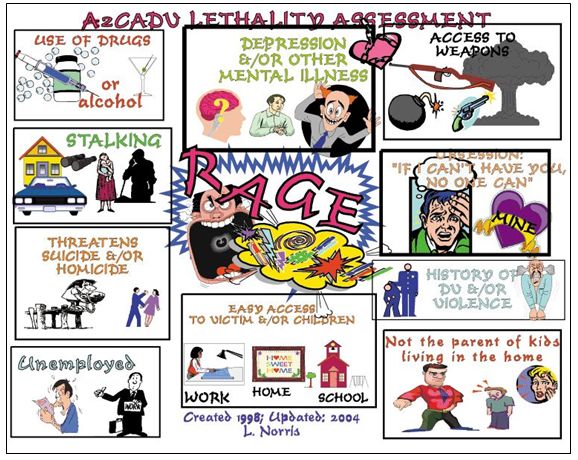The primary goal for most shelters is maintaining the present and future safety of women and their children, which can be supported by working with women to assess their level of risk for repeated violence or lethality, and assisting in safety planning interventions that help women to identify options for keeping themselves safe.
Risk assessments can help women become aware of and reflect on specific factors that threaten their safety and their overall level of risk for future violence. They are a critical activity for ensuring women’s safety in the short and medium-term and should be conducted at various points during a woman’s stay in a shelter:
- Initial risk assessment should be completed during the early period following a woman’s arrival at the shelter. The specific questions addressed in the assessment will vary depending on the form of violence experienced. In many shelters, a risk assessment tool is used to understand the range of specific factors that place the woman (or where relevant, girl) at risk. In situations of trafficking, this initial assessment may be a generic review of the woman's situation and the broader protective measures and circumstances related to trafficking in the country.
- Ongoing assessment of risk, based on a woman’s changing cirucumstances, is important to review at least every three months or ideally once per month. During periods of high risk, assessments may need to be reviewed weekly or daily (International Organization for Migration, 2007).
- Specific assessment of risks is needed in response to particular events or circumstances that pose an increased threat, based on the distinct risks identified for the woman. For example, women and children may be exposed to an increased level of risk once they leave the shelter, and should consider these factors carefully when planning for their transition into the community.
Considerations for conducting risk assessments include:
- Women should be central in assessing their own level of risk, which is important both to empower women and provides an important indicator of risk for repeated domestic violence.
- Shelter staff should be informed of the risk factors relevant for the form of violence that the woman or girl is experiencing (e.g. risk of repeated domestic violence; lethality or intimate partner murder; re-trafficking; among general risk factors for various forms of violence against women).
- There are limitations to the accuracy of risk assessment conducted by both professionals and women themselves. Some research indicates that many women who were killed or almost killed, did not think that their partner was capable of murder. This suggests that women's assessment of their own risk should be used as just one indicator of risk for continued, escalating abuse and femicide.
- Risk assessment tools are valuable in understanding the known risks for repeated acts of violence, although no risk assessment approach or tool is completely reliable in accurately predicting violence. It is very important to be cautious when using them, as most tools have undergone little research. A single tool or process should not be used to predict a women's or girl's level of risk, but should be incorporated among various sources of information cleared by the woman (i.e. registration information, assessments from different service providers, police or judicial records, etc.), to effectively promote the woman's safety.
- Risk assessment tools should never be used to minimize a woman's impressions of her level of risk, even if the score is below the woman’s perception. There is a danger when using risk assessments that are inconsistent with her perception and should not be used in isolation to determine her actual risk. It is essential that the woman's perception of risk is considered an important factor in the overall assessment of risk, regardless of what a risk tool indicates.
- Attention should be given to ensure that women identified as high risk does not result in less attention and assistance to those assessed at lesser risk. Adequate support should be provided to all women at risk.
- Staff should receive specific training and supervision in conducting risk assessments to ensure the process is implemented accurately and effectively, to understand and respond appropriately to women’s various levels of risk.
(Campbell, Webster & Glass, 2009; WAVE, 2010; Gondolf, 2002 as cited in WAVE, 2010; International Organization for Migration, 2007)
Prior to beginning the assessment, and upon gaining informed consent to conduct the process, staff should inform woman how long the assessment is expected to take; and review the concept of risk with her, reminding her why the questions are being asked (Richards, 2009). Risk assessment should follow a consistent and standardized process based on known indicators of risk. A variety of tools and processes have been developed that provide detailed guidance on how to implement risk assessment practices. Once the risk assessment is completed, the results should be discussed with the woman in a sensitive manner, taking into consideration the potential impact of revealing that a woman is at high risk of serious harm or femicide.
When sharing results, shelter staff should:
- State clearly the specific concerns, providing both the answers given by the woman and the related professional judgement of risk based on known risk factors.
- Explain the next steps (e.g. safety planning, referrals to other resources, etc.).
- In cases of 'honour-related violence', describing the systems in place to ensure that family members will not be contacted or informed (Richards, 2009; CAADA, 2009).

Information gathered through risk assessments conducted (generic and specific) should be used to develop a safety plan that addresses each area of risk identified.
Risk assessment in domestic violence cases may examine the likelihood of repeated abuse or the risk of lethality.